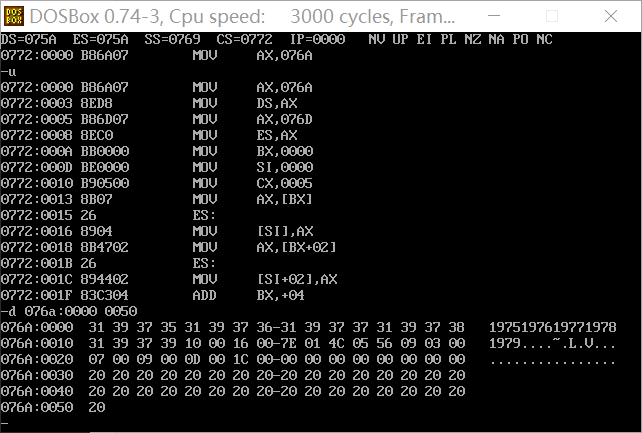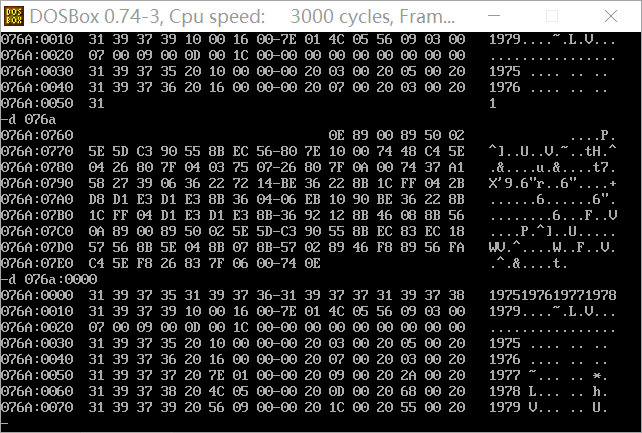1. Task 1
1-1
Assemble and connect task1_1.asm

Use the g command to break the point, stop the program until line 17, and check the value of the register

(1)ds=076A;
ss=076B;
cs=076C;
(2)ds=X-0002;
ss=X-0001;
1-2

(1)ds=076A
ss=076B;
cs=076C;
(2)ds=X-0002;
ss=X-0001;
1-3

(1)ds=076A
ss=076C;
cs=076E;
(2)ds=X-0004;
ss=X-0002;
1-4

(1)ds=076C;
ss=076E;
cs=076A;
(2)ds=X+0002;
ss=X+0004;
1-5
(1) If the data in the segment accounts for n bytes, after the program is loaded, the space actually occupied by the segment is (n+15)/16, that is, the N/16 is rounded up, because the segment size is an integer multiple of 16 bytes, and the dissatisfied part should also be supplemented with 16 bytes.
(2)
Only 1-4 can be executed for the following reasons:
The start label indicates the beginning of the program segment, and end start indicates the end of the program segment. Start and end start must appear in pairs. If end start does not exist, the start label is ignored and treated as the default. When the beginning of the program is the program entry, it can be defaulted.
Only 1-4 starts with a code segment, so only 1-4 can be executed.
2. Task 2
The code is as follows:
assume cs:code
code segment
mov ax,0b800h
mov ds,ax
mov bx,0f00h
mov cx,80
p:
mov ds:[bx],0403h
inc bx
inc bx
loop p
mov ah,4ch
int 21h
code ends
The results are as follows:

3. Task 3
The code is as follows
assume cs:code data1 segment db 50, 48, 50, 50, 0, 48, 49, 0, 48, 49 ; ten numbers data1 ends data2 segment db 0, 0, 0, 0, 47, 0, 0, 47, 0, 0 ; ten numbers data2 ends data3 segment db 16 dup(0) data3 ends code segment start: mov ax,data1 mov ds,ax mov ax,data2 mov es,ax mov ax,data3 mov ss,ax mov bx,0 mov cx,10 s: mov ax,0 add ax,ds:[bx] add ax,es:[bx] mov ss:[bx],ax inc bx loop s mov ax,4c00h int 21h code ends end start
Value when code snippet is not entered

data1 is 10 units starting from 076a: 0000. Data2 and data3 start from 076b and 076c respectively. It can be seen that all 076c are 0 at this time
After operation, the 076c results are as follows

Becomes data1+data2
4. Task 4
The code is as follows:
assume cs:code
data1 segment
dw 2, 0, 4, 9, 2, 0, 1, 9
data1 ends
data2 segment
dw 8 dup(?)
data2 ends
code segment
start:
mov ax,data1
mov ds,ax
mov ax,data2
mov ss,ax
mov cx,8
mov sp,16
mov bx,0
s:
mov ax,[bx]
push ax
inc bx
inc bx
loop s
mov ah, 4ch
int 21h
code ends
end start
Before entering the code snippet:

After the code snippet runs

5. Task 5
Run program

Execute between lines 25 and 27

line 19 action
Sum the memory unit value in data1 with 0dfh, that is, the hexadecimal number df, and df is converted into binary to 11011111. The sum operation turns the original number of bit 6 into 0,
The upper case letters ascii range from 01000001 to 01011010, and the lower case letters are 0110001-01111010. Therefore, change the 1 in the sixth digit of the lower case letter to 0 to convert lower case to upper case,
The original 0 of the capital letter remains unchanged, so all letters in line 19 become capital.
Change to db 5 dup(2)
The results are as follows:

A character occupies a word, that is, 2 bytes. Does the low byte represent ascii, the high byte represents character parameters, the high 4-bit background color, and the color of the fourth character itself.
6. Task 6
assume cs:code, ds:data data segment db 'Pink Floyd ' db 'JOAN Baez ' db 'NEIL Young ' db 'Joan Lennon ' data ends code segment start: mov ax,data mov ds,ax mov cx,4 mov bx,0 s: mov dx,cx mov cx,4 mov si,0 p: mov al,ds:[bx+si] or al,00100000B mov ds:[bx+si],al inc si loop p add bx,16 mov cx,dx loop s mov ah, 4ch int 21h code ends end start


7. Task 7
assume cs:code, ds:data, es:table data segment db '1975', '1976', '1977', '1978', '1979' dw 16, 22, 382, 1356, 2390 dw 3, 7, 9, 13, 28 data ends table segment db 5 dup( 16 dup(' ') ) ; table ends code segment start: mov ax,data mov ds,ax mov ax,table mov es,ax mov bx,0 mov si,0 mov cx,5 p: mov ax,ds:[bx] mov es:[si],ax mov ax,ds:[bx+2] mov es:[si+2],ax add bx,4 add si,16 loop p mov bx,20 mov cx,5 mov si,5 s: mov ax,0 mov es:[si+2],ax mov ax,ds:[bx] mov es:[si],ax add bx,2 add si,16 loop s mov bx,30 mov cx,5 mov si,10 q: mov ax,ds:[bx] mov es:[si],ax add bx,2 add si,16 loop q mov cx,5 mov si,0 r: mov ax,es:[si+5] mov dx,es:[si+7] div word ptr es:[si+10] mov es:[si+13],ax add si,16 loop r mov ah, 4ch int 21h code ends end start
assume cs:code, ds:data, es:table data segment db '1975', '1976', '1977', '1978', '1979' dw 16, 22, 382, 1356, 2390 dw 3, 7, 9, 13, 28 data ends table segment db 5 dup( 16 dup(' ') ) ; table ends code segment start: mov ax,data mov ds,ax mov ax,table mov es,ax mov bx,0 mov si,0 mov cx,5 p: mov ax,ds:[bx] mov es:[si],ax mov ax,ds:[bx+2] mov es:[si+2],ax add bx,4 add si,16 loop p mov bx,20 mov cx,5 mov si,5 s: mov ax,0 mov es:[si+2],ax mov ax,ds:[bx] mov es:[si],ax add bx,2 add si,16 loop s mov bx,30 mov cx,5 mov si,10 q: mov ax,ds:[bx] mov es:[si],ax add bx,2 add si,16 loop q mov cx,5 mov si,0 r: mov ax,es:[si+5] mov dx,es:[si+7] div word ptr es:[si+10] mov es:[si+13],ax add si,16 loop r mov ah, 4ch int 21h code ends end start
Before and after operation:


Experiment summary:
1. Master the usage of loop through this experiment.
2. Understand the method of changing the case of letters through and, or operation
3. Understand the storage mode of characters in memory.